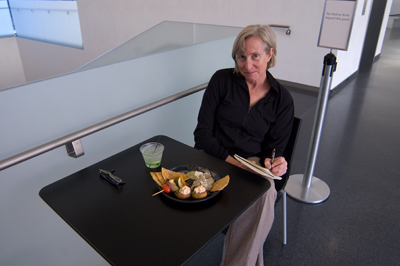
You'll find here, under the heading of The Art Tourist, entries written by and for people who look at contemporary art. The pieces are verbal descriptions of experiences generated by looking at an exhibition or other display of stuff in the visual art context today, thus the use of the words contemporary (of our time) and art.
If you look at contemporary art, you know you may see
drawing, painting, crafts, photos, video, stuff laying around, sounds, performances or simply idea. And you might be asked to do
something with some stuff, or smell, or just hear. You probably have
heard the current period called Post Modernism, Pluralism or described as "anything
goes."
If you look at contemporary art, you may have had experience the Art Tourist describes. Sometimes you leave a museum or gallery and you can't stop talking about the stuff seen, or you need to come back again. Sometimes you feel confused and want someone to just give it up and explain what's going on, or you leave thinking precious time was wasted.
Understanding the experiences and thoughts of other humans joins us as a species and makes each one of us more than just the stuff inside a fleshy shell. Art can be a conductor, a facilitator, to this intra-species understanding. This blog attempts to crank up some energy about looking at art, and to reflect on how well art enterprises/institutions do the job of communicating to a regular viewer like us.
The art tourist entries are viewer-centric, a viewer who openly chooses to look, but who hasn't necessarily seen the bio-pic of the artist or mind melded with the curator. If art is made to communicate, then a regular viewer should be able to see an exhibition or a piece of art and get something from it. If it needs explanation, if we must know the title, if we need 3-D glasses, then somehow that art enterprise/institution should reveal what is needed, before they reveal when and where we can see it.
The Art Tourist is not an investigative reporter who finds out
why someone made the art, or how difficult the show was to transport or
acquire, or assemble, or how much it means to the curator or cost an
institution, or if anything is selling - unless that's part of the art
and is presented to the ordinary viewer. The aim is to expose a bit of what can be obtained from seeing the show.
Hopefully, these texts will add something of their own to our human experience, and you will talk about it for a minute, or two later.